| Coffea | |
|---|---|
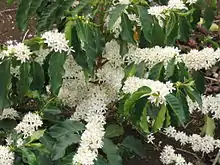 | |
| Flowering branches of Coffea arabica | |
| Scientific classification | |
| Kingdom: | Plantae |
| Clade: | Tracheophytes |
| Clade: | Angiosperms |
| Clade: | Eudicots |
| Clade: | Asterids |
| Order: | Gentianales |
| Family: | Rubiaceae |
| Tribe: | Coffeeae |
| Genus: | Coffea L. |
| Type species | |
| Coffea arabica | |
Coffea is a genus of flowering plants in the family Rubiaceae. Coffea species are shrubs or small trees native to tropical and southern Africa and tropical Asia. The seeds of some species, called coffee beans, are used to flavor various beverages and products. The fruits, like the seeds, contain a large amount of caffeine, and have a distinct sweet taste.
The plant ranks as one of the world's most valuable and widely traded commodity crops and is an important export product of several countries, including those in Central and South America, the Caribbean and Africa. The coffee trade relies heavily on two of the over 120 species, Coffea arabica (commonly known simply as "Arabica"), which accounts for 60–80% of the world's coffee production, and Coffea canephora (known as "Robusta"), which accounts for about 20–40%. [1][2] Both coffee species are vulnerable to shifting growing zones caused by climate change, likely to result in a decline in production in some of the most important growing regions.[3][4][5]
Cultivation and use
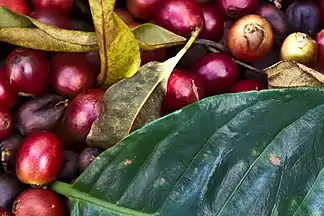

There are over 120 species of Coffea, which is grown from seed. The two most popular are Coffea arabica (commonly known simply as "Arabica"), which accounts for 60–80% of the world's coffee production, and Coffea canephora (known as "Robusta"), which accounts for about 20–40%.[1][2] C. arabica is preferred for its sweeter taste, while C. canephora has a higher caffeine content. C. arabica has its origins in the highlands of Ethiopia and the Boma Plateau of Sudan, and was the result of a hybrid between C. canephora and C. eugenioides.[6]
The trees produce edible red or purple fruits, which are described either as epigynous berries or as indehiscent drupes.[7] The fruit is often referred to as a "coffee cherry," and it contains two seeds, called "coffee beans."[8] Despite these terms, coffee is neither a true cherry (the fruit of certain species in the genus Prunus) nor a true bean (seeds from plants in the family Fabaceae).
In about 5–10% of any crop of coffee fruits, only a single bean is found. Called a peaberry, it is smaller and rounder than a normal coffee bean.
When grown in the tropics, coffee is a vigorous bush or small tree that usually grows to a height of 3–3.5 m (9.8–11.5 ft). Most commonly cultivated coffee species grow best at high elevations, but do not tolerate freezing temperatures.[9]
The tree of Coffea arabica will grow fruits after three to five years, producing for an average of 50 to 60 years, although up to 100 is possible.[10] The white flowers are highly scented. The fruit takes about nine months to ripen.




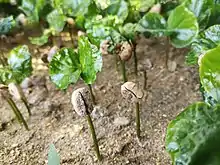
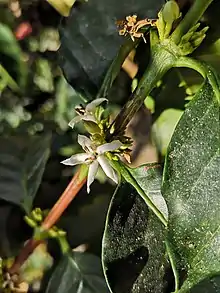

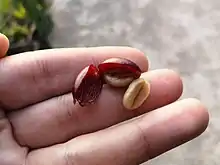

Ecology
The caffeine in coffee beans serves as a toxic substance protecting the seeds of the plant, a form of natural plant defense against herbivory. Caffeine simultaneously attracts pollinators, specifically honeybees, by creating an olfactory memory that signals bees to return to the plant's flowers.[11] Not all Coffea species contain caffeine, and the earliest species had little or no caffeine content. Caffeine has evolved independently in multiple lineages of Coffea in Africa, perhaps in response to high pest predation in the humid environments of West-Central Africa.[11] Caffeine has also evolved independently in the more distantly related genera Theobroma (cacao) and Camellia (tea).[12] This suggests that caffeine production is an adaptive trait in coffee and plant evolution. The fruit and leaves also contain caffeine, and can be used to make coffee cherry tea and coffee-leaf tea. The fruit is also used in many brands of soft drink as well as pre-packaged teas.[13][14][15][16]
Several insect pests affect coffee production, including the coffee borer beetle (Hypothenemus hampei) and the coffee leafminer (Leucoptera caffeina).
Coffee is used as a food plant by the larvae of some Lepidoptera (butterfly and moth) species, Dalcera abrasa, turnip moth and some members of the genus Endoclita, including E. damor and E. malabaricus.
Research
New species of Coffea are still being identified in the 2000s. In 2008 and 2009, researchers from the Royal Botanic Gardens, Kew named seven from the mountains of northern Madagascar, including C. ambongensis, C. boinensis, C. labatii, C. pterocarpa, C. bissetiae, and C. namorokensis.[17]
In 2008, two new species were discovered in Cameroon. Coffea charrieriana, which is caffeine-free, and Coffea anthonyi.[18] By crossing the new species with other known coffees, two new features might be introduced to cultivated coffee plants: beans without caffeine and self-pollination.
In 2011, Coffea absorbed the twenty species of the former genus Psilanthus due to the morphological and genetic similarities between the two genera.[19] Historically, the two have been considered distinct genera due to differences in the length of the corolla tube and the anther arrangement: Coffea with a short corolla tube and exserted style and anthers; Psilanthus with a long corolla tube and included anthers. However, these characteristics were not present in all species of either respective genus, making the two genera overwhelmingly similar in both morphology and genetic sequence. This transfer expanded Coffea from 104 species to 124, and extended its native distribution to tropical Asia and Australasia.
In 2014, the coffee genome was published, with more than 25,000 genes identified. This revealed that coffee plants make caffeine using a different set of genes from those found in tea, cacao and other such plants.[20]
In 2017, a robust and almost fully resolved phylogeny of the entire genus was published.[11] In addition to resolving the relationships of Coffea species, this study's results suggest Africa or Asia as the likely ancestral origin of Coffea and point to several independent radiations across Africa, Asia, and the Western Indian Ocean Islands.
In 2020 a technique of DNA fingerprinting, or genetic authentication of plant material was proven effective for coffee.[21] For the study, scientists used DNA extraction and SSR marker analysis. This technique or ones similar may allow for several improvements to coffee production such as improved information for farmers as to the susceptibility of their coffee plants to pests and disease, a professionalized coffee seed system, and transparency and traceability for buyers of green, un-roasted coffee.
Species
- Coffea abbayesii J.-F.Leroy
- Coffea affinis De Wild.
- Coffea alleizettii Dubard
- Coffea ambanjensis J.-F.Leroy
- Coffea ambongenis J.-F.Leroy ex A.P.Davis
- Coffea andrambovatensis J.-F.Leroy
- Coffea ankaranensis J.-F.Leroy ex A.P.Davis
- Coffea anthonyi Stoff. & F.Anthony
- Coffea arabica L.
- Coffea arenesiana J.-F.Leroy
- Coffea augagneurii Dubard
- Coffea bakossii Cheek & Bridson
- Coffea benghalensis B.Heyne ex Schult.
- Coffea bertrandii A.Chev.
- Coffea betamponensis Portères & J.-F.Leroy
- Coffea bissetiae A.P.Davis & Rakotonas.
- Coffea boinensis A.P.Davis & Rakotonas.
- Coffea boiviniana A.P.Davis & Rakotonas.
- Coffea bonnieri Dubard
- Coffea brassii (J.-F.Leroy) A.P.Davis
- Coffea brevipes Hiern
- Coffea bridsoniae A.P.Davis & Mvungi
- Coffea buxifolia A.Chev.
- Coffea canephora ("Coffea robusta") Pierre ex A.Froehner
- Coffea carrissoi A.Chev.
- Coffea charrieriana Stoff. & F.Anthony
- Coffea cochinchinensis Pierre ex Pit.
- Coffea commersoniana (Baill.) A.Chev.
- Coffea congensis A.Froehner
- Coffea costatifructa Bridson
- Coffea coursiana J.-F.Leroy
- Coffea dactylifera Robbr. & Stoff.
- Coffea decaryana J.-F.Leroy
- Coffea dubardii Jum.
- Coffea ebracteolata (Hiern) Brenan
- Coffea eugenioides S.Moore
- Coffea fadenii Bridson
- Coffea farafanganensis J.-F.Leroy
- Coffea floresiana Boerl.
- Coffea fotsoana Stoff. & Sonké
- Coffea fragilis J.-F.Leroy
- Coffea fragrans Wall. ex Hook.f.
- Coffea gallienii Dubard
- Coffea grevei Drake ex A.Chev.
- Coffea heimii J.-F.Leroy
- Coffea homollei J.-F.Leroy
- Coffea horsfieldiana Miq.
- Coffea humbertii J.-F.Leroy
- Coffea humblotiana Baill.
- Coffea humilis A.Chev.
- Coffea jumellei J.-F.Leroy
- Coffea kapakata (A.Chev.) Bridson
- Coffea kianjavatensis J.-F.Leroy
- Coffea kihansiensis A.P.Davis & Mvungi
- Coffea kimbozensis Bridson
- Coffea kivuensis Lebrun
- Coffea labatii A.P.Davis & Rakotonas.
- Coffea lancifolia A.Chev.
- Coffea lebruniana Germ. & Kester
- Coffea leonimontana Stoff.
- Coffea leroyi A.P.Davis
- Coffea liaudii J.-F.Leroy ex A.P.Davis
- Coffea liberica Hiern
- Coffea ligustroides S.Moore
- Coffea littoralis A.P.Davis & Rakotonas.
- Coffea lulandoensis Bridson
- Coffea mabesae (Elmer) J.-F.Leroy
- Coffea macrocarpa A.Rich.
- Coffea madurensis Teijsm. & Binn. ex Koord.
- Coffea magnistipula Stoff. & Robbr.
- Coffea malabarica (Sivar., Biju & P.Mathew) A.P.Davis
- Coffea mangoroensis Portères
- Coffea mannii (Hook.f.) A.P.Davis
- Coffea manombensis A.P.Davis
- Coffea mapiana Sonké, Nguembou & A.P.Davis
- Coffea mauritiana Lam.
- Coffea mayombensis A.Chev.
- Coffea mcphersonii A.P.Davis & Rakotonas.
- Coffea melanocarpa Welw. ex Hiern
- Coffea merguensis Ridl.
- Coffea millotii J.-F.Leroy
- Coffea minutiflora A.P.Davis & Rakotonas.
- Coffea mogenetii Dubard
- Coffea mongensis Bridson
- Coffea montekupensis Stoff.
- Coffea montis-sacri A.P.Davis
- Coffea moratii J.-F.Leroy ex A.P.Davis & Rakotonas.
- Coffea mufindiensis Hutch. ex Bridson
- Coffea myrtifolia (A.Rich. ex DC.) J.-F.Leroy
- Coffea namorokensis A.P.Davis & Rakotonas.
- Coffea neobridsoniae A.P.Davis
- Coffea neoleroyi A.P.Davis
- Coffea perrieri Drake ex Jum. & H.Perrier
- Coffea pervilleana (Baill.) Drake
- Coffea pocsii Bridson
- Coffea pseudozanguebariae Bridson
- Coffea pterocarpa A.P.Davis & Rakotonas.
- Coffea racemosa Lour.
- Coffea rakotonasoloi A.P.Davis
- Coffea ratsimamangae J.-F.Leroy ex A.P.Davis & Rakotonas.
- Coffea resinosa (Hook.f.) Radlk.
- Coffea rhamnifolia (Chiov.) Bridson
- Coffea richardii J.-F.Leroy
- Coffea sahafaryensis J.-F.Leroy
- Coffea sakarahae J.-F.Leroy
- Coffea salvatrix Swynn. & Philipson
- Coffea sambavensis J.-F.Leroy ex A.P.Davis & Rakotonas.
- Coffea sapinii (De Wild.) A.P.Davis
- Coffea schliebenii Bridson
- Coffea semsei (Bridson) A.P.Davis
- Coffea sessiliflora Bridson
- Coffea stenophylla G.Don
- Coffea tetragona Jum. & H.Perrier
- Coffea togoensis A.Chev.
- Coffea toshii A.P.Davis & Rakotonas.
- Coffea travancorensis Wight & Arn.
- Coffea tricalysioides J.-F.Leroy
- Coffea tsirananae J.-F.Leroy
- Coffea vatovavyensis J.-F.Leroy
- Coffea vavateninensis J.-F.Leroy
- Coffea vianneyi J.-F.Leroy
- Coffea vohemarensis A.P.Davis & Rakotonas.
- Coffea wightiana Wall. ex Wight & Arn.
- Coffea zanguebariae Lour.
References
- 1 2 "Coffee Plant: Arabica and Robusta". Coffee Research Institute. Retrieved 17 November 2018.
- 1 2 "Coffee: World Markets and Trade" (PDF). United States Department of Agriculture – Foreign Agricultural Service. 16 June 2017. Archived (PDF) from the original on 10 October 2017. Retrieved 8 December 2017.
- ↑ Läderach, Peter; Ramirez–Villegas, Julian; Navarro-Racines, Carlos; Zelaya, Carlos; Martinez–Valle, Armando; Jarvis, Andy (26 October 2016). "Climate change adaptation of coffee production in space and time". Climatic Change. 141 (1): 47–62. doi:10.1007/s10584-016-1788-9. ISSN 0165-0009.
- ↑ Moat, Justin; Williams, Jenny; Baena, Susana; Wilkinson, Timothy; Gole, Tadesse W.; Challa, Zeleke K.; Demissew, Sebsebe; Davis, Aaron P. (19 June 2017). "Resilience potential of the Ethiopian coffee sector under climate change". Nature Plants. 3 (7): 17081. doi:10.1038/nplants.2017.81. ISSN 2055-0278. PMID 28628132. S2CID 6873955.
- ↑ Worland, Justin (21 June 2018). "Your Morning Cup of Coffee Is in Danger. Can the Industry Adapt in Time?". Time. Archived from the original on 4 August 2019. Retrieved 13 October 2019.
- ↑ Lashermes, P.; Combes, M.-C.; Robert, J.; Trouslot, P.; D'Hont, A.; Anthony, F.; Charrier, A. (1999). "Molecular characterisation and origin of the Coffea arabica L. genome". Molecular and General Genetics. 261 (2): 259–266. doi:10.1007/s004380050965. PMID 10102360. S2CID 7978085.
- ↑ Davis, Aaron P.; Govaerts, Rafael; Bridson, Diane M. & Stoffelen, Piet (2006). "An annotated taxonomic conspectus of the genus Coffea (Rubiaceae)". Botanical Journal of the Linnean Society. 152 (4): 465–512. doi:10.1111/j.1095-8339.2006.00584.x.
- ↑ "What is Coffee?". www.ncausa.org. Retrieved 14 July 2020.
- ↑ Petek, Marcos Rafael; Sera, Tumoru; Alteia, Marcos Zorzenon (January 2005). "Genetic variability for frost resistance among Coffea accessions assessed in the field and in a cold chamber". Brazilian Archives of Biology and Technology. 48 (1): 15–21. doi:10.1590/S1516-89132005000100003.
- ↑ "Coffee bean: commodity factsheet" (PDF). Mintec. Archived (PDF) from the original on 20 November 2016.
- 1 2 3 Hamon, Perla; Grover, Corrinne E.; Davis, Aaron P.; Rakotomalala, Jean-Jacques; Raharimalala, Nathalie E.; Albert, Victor A.; Sreenath, Hosahalli L.; Stoffelen, Piet; Mitchell, Sharon E.; Couturon, Emmanuel; Hamon, Serge; de Kochko, Alexandre; Crouzillat, Dominique; Rigoreau, Michel; Sumirat, Ucu; Akaffou, Sélastique & Guyot, Romain (2017). "Genotyping-by-sequencing provides the first well-resolved phylogeny for coffee (Coffea) and insights into the evolution of caffeine content in its species: GBS coffee phylogeny and the evolution of caffeine content". Molecular Phylogenetics and Evolution. 109: 351–361. doi:10.1016/j.ympev.2017.02.009. PMID 28212875.
- ↑ Denoeud, France; et al. (5 September 2014). "The coffee genome provides insight into the convergent evolution of caffeine biosynthesis". Science. 345 (6201): 1181–1184. Bibcode:2014Sci...345.1181D. doi:10.1126/science.1255274. PMID 25190796.
- ↑ Selby, Craig (31 May 2019). "SlimCafe is no longer available". SlimFast.
- ↑ "Coffeeberry Cascara – Soluble, Sustainable | FutureCeuticals". www.futureceuticals.com.
- ↑ "Starbucks". stories.starbucks.com.
- ↑ "Brazilian Cascara". Dwellers Coffee. Archived from the original on 19 April 2021. Retrieved 20 July 2019.
- ↑ "Seven species of wild coffee amongst Kew's haul of new discoveries". Royal Botanic Gardens, Kew. 22 December 2009. Archived from the original on 30 August 2016.
- ↑ Stoffelen, Piet; Noirot, Michel; Couturon, Emmanuel; Anthony, François (2008). "A new caffeine-free coffee from Cameroon". Botanical Journal of the Linnean Society. 158 (1): 67–72. doi:10.1111/j.1095-8339.2008.00845.x.
- ↑ Davis, A.P.; Tosh, J.; Ruch, N.; Fay, M.F. (2011). "Growing coffee: Psilanthus (Rubiaceae) subsumed on the basis of molecular and morphological data; implications for the size, morphology, distribution and evolutionary history of Coffea". Botanical Journal of the Linnean Society. 167 (4): 357–377. doi:10.1111/j.1095-8339.2011.01177.x.
- ↑ Callaway, Ewen (4 September 2014). "Coffee got its buzz by a different route than tea". Nature. doi:10.1038/nature.2014.15832. S2CID 168085931.
- ↑ Pruvot-Woehl, Solène; Krishnan, Sarada; Solano, William; Schilling, Tim; Toniutti, Lucile; Bertrand, Benoit; Montagnon, Christophe (1 April 2020). "Authentication of Coffea arabica Varieties through DNA Fingerprinting and its Significance for the Coffee Sector". Journal of AOAC International. 103 (2): 325–334. doi:10.1093/jaocint/qsz003. ISSN 1060-3271. PMID 33241280. Retrieved 1 April 2021.
